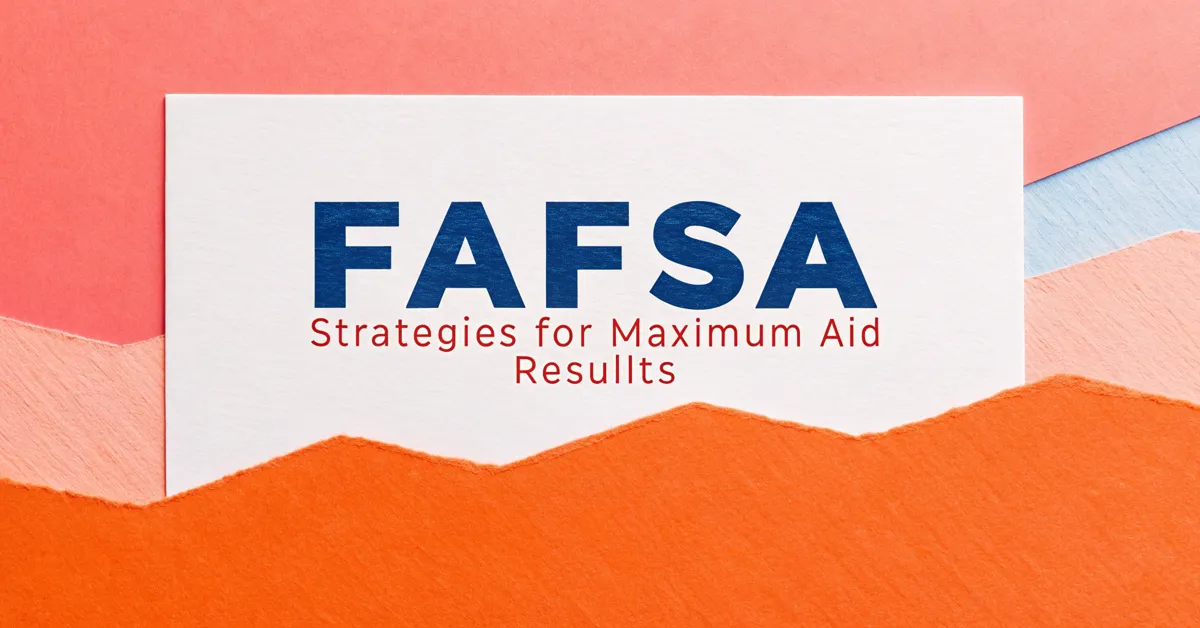Navigating the financial aid process for college can feel like trying to solve a complex puzzle. The Free Application for Federal Student Aid (FAFSA) is often the key piece, but understanding how to maximize your aid eligibility can be daunting. Many families miss out on potential aid simply because they don’t know the ins and outs of the FAFSA.
This guide aims to simplify the FAFSA process, providing you with actionable strategies to improve your chances of receiving the maximum aid possible. We’ll break down the often-confusing requirements and offer tips to help you navigate the application effectively. Preparing for college is a big financial undertaking, so making sure you get all the help you’re entitled to can be a real game changer.
We’ll dive deep into the details, but don’t worry, we’ll keep it simple and easy to follow.
FAFSA Help: Understanding the Basics
Before diving into strategies, it’s key to have a solid grasp of what the FAFSA is and how it works. The FAFSA is a form you fill out to see if you can get money from the government for college. It looks at things like your family’s money and how many people are in your family to figure out how much help you might need. Colleges also use this information to decide on other types of aid they can offer.
The FAFSA is free to complete, and it opens every year on October 1st (though recent changes have shifted the opening date, so stay updated). It’s a gateway to federal student aid, including grants, loans, and work-study programs. Many states and colleges also use FAFSA data to award their own financial aid, making it a crucial first step in planning for college costs.
Who Should Fill Out the FAFSA?
Almost everyone planning to attend college should fill out the FAFSA. Even if you think your family makes too much money to qualify for aid, it’s still worth completing. Many colleges require the FAFSA for certain types of merit-based scholarships, and you might be surprised by the amount of aid you’re eligible for. Plus, it’s required to receive federal student loans, which can be a valuable resource for many families.
Key FAFSA Terms
Understanding the jargon is half the battle. Here are a few essential terms:
- EFC (Expected Family Contribution): This is an estimate of how much your family can contribute to college costs. It’s used to figure out how much financial aid you might need. Note: The EFC has been replaced with the SAI (Student Aid Index) as of the 2024-25 FAFSA.
- SAI (Student Aid Index): Starting with the 2024-25 FAFSA, the SAI replaces the EFC. It is designed to provide a fairer and more accurate assessment of a family’s ability to pay for college.
- Cost of Attendance (COA): This is the total cost of attending a particular college, including tuition, fees, room and board, books, and other expenses.
- Financial Need: This is the difference between the COA and your SAI. It determines the amount of need-based aid you are eligible for.
FAFSA Help: Strategies to Maximize Your Aid
Now let’s get into the nitty-gritty of maximizing your aid results. These strategies focus on providing the most accurate information, understanding how the FAFSA assesses your finances, and taking steps to improve your eligibility where possible.
1. File Early
Filing the FAFSA early is one of the most straightforward ways to increase your chances of getting more aid. While the federal deadline is usually in late June, many states and colleges have their own deadlines, some of which are much earlier. These deadlines can be on a first-come, first-served basis.
The earlier you file, the better your chances of accessing limited funds. It can be helpful to consult your state’s higher education agency to know when your state’s FAFSA opens and closes.
2. Gather All Necessary Documents
Before you begin the FAFSA, gather all the documents you’ll need. This will make the process smoother and reduce the risk of errors. Common documents include:
- Social Security numbers for parents and students
- Federal income tax returns (IRS Form 1040)
- W-2 forms
- Records of untaxed income, such as Social Security benefits or child support
- Bank statements
- Investment records
- Records of any other assets
Having these documents handy will help you complete the FAFSA accurately and efficiently. This is especially helpful because the application saves every so often.
3. Report Income and Assets Accurately
Accuracy is paramount. It is vital to report all income and assets accurately. The FAFSA uses this information to calculate your SAI, which determines your financial aid eligibility. Errors or omissions can result in a lower aid package or even disqualification.
Be truthful and consistent with your reporting. Don’t try to hide assets or underreport income, as this can lead to serious consequences. The FAFSA undergoes verification processes, and discrepancies can be flagged.
4. Understand Asset Protection Strategies
While you need to report assets accurately, it’s useful to know which assets are considered when determining your financial aid eligibility. Certain assets are not counted on the FAFSA, which can help lower your SAI.
- Retirement accounts: Assets held in retirement accounts, such as 401(k)s, 403(b)s, IRAs, and Roth IRAs, are not considered assets on the FAFSA.
- Home equity: The value of your primary residence is also not considered an asset on the FAFSA.
Knowing these exemptions can help you strategically manage your assets to improve your aid eligibility. Moving funds into a retirement account, if feasible, can reduce your reportable assets and potentially increase your aid.
5. Be Aware of the Impact of Parental Assets
Parental assets are assessed at a lower rate than student assets on the FAFSA. This means that having assets in a parent’s name, rather than the student’s name, can reduce the overall SAI.
The FAFSA considers up to 5.64% of parental assets, while it considers 20% of student assets. This difference can have a significant impact on your financial aid eligibility.
If possible, try to shift assets into a parent’s name, especially if the student has substantial savings or investments. This can help lower the SAI and increase the amount of aid you’re eligible for.
6. Minimize Student Income
Student income is assessed at a much higher rate than parental income on the FAFSA. The FAFSA considers up to 50% of a student’s income above a certain threshold, while it only considers a small percentage of parental income.
Encourage students to minimize their income during the base year. The base year is the tax year used to complete the FAFSA. For example, if you’re filling out the FAFSA for the 2024-25 school year, you’ll use your 2022 tax information. Reducing student income during this year can lower the SAI and increase aid eligibility.
7. Understand the Impact of Divorced or Separated Parents
If parents are divorced or separated, the FAFSA requires information only from the custodial parent. The custodial parent is the parent with whom the student lived with for more time during the 12 months prior to filing the FAFSA. If the student lived with each parent for an equal amount of time, the custodial parent is the parent who provided more financial support during the year.
Only the custodial parent’s income and assets are considered on the FAFSA. If the custodial parent has a lower income and asset base than the noncustodial parent, this can increase the student’s aid eligibility. In cases where the custodial parent remarried, the stepparent’s income and assets are also considered on the FAFSA.
8. Report Special Circumstances
The FAFSA provides an opportunity to report any special circumstances that may affect your family’s ability to pay for college. These circumstances can include:
- Loss of income due to job loss or reduced hours
- Unusual medical expenses
- Death of a parent or spouse
- Other significant financial hardships
Reporting these circumstances can trigger a “professional judgment” review by the college’s financial aid office. This review allows the financial aid office to adjust your SAI based on your family’s unique situation.
To report special circumstances, include a detailed explanation with your FAFSA submission or contact the college’s financial aid office directly. Provide supporting documentation, such as medical bills, unemployment letters, or death certificates.
9. Appeal Your Financial Aid Award
If you’re not satisfied with the financial aid award you receive from a college, don’t hesitate to appeal. An appeal is a formal request to the college’s financial aid office to reconsider your aid package.
To appeal your financial aid award, write a letter to the financial aid office explaining why you believe your aid package is insufficient. Provide supporting documentation, such as tax returns, income statements, or medical bills. Highlight any special circumstances that may affect your family’s ability to pay for college.
Be polite and professional in your appeal letter, and clearly state the amount of additional aid you’re requesting. The financial aid office may be willing to increase your grant aid, reduce your loan amounts, or offer other forms of assistance.
10. Consider Community College
Attending a community college for the first one or two years can significantly reduce your overall college costs. Community colleges typically have much lower tuition rates than four-year colleges and universities.
Students can save thousands of dollars by completing their general education requirements at a community college before transferring to a four-year institution to complete their bachelor’s degree.
Plus, many community colleges offer financial aid and scholarship opportunities, making them an affordable option for students from low-income families.
11. Seek Out Scholarships
Scholarships are a great way to reduce your reliance on student loans. Unlike loans, scholarships don’t need to be repaid. They can come from a variety of sources, including:
- Colleges and universities
- Private organizations
- Foundations
- Corporations
- Professional associations
Start your scholarship search early and apply for as many scholarships as you’re eligible for. There are scholarships available for students of all backgrounds and interests, so take the time to research and apply.
12. Explore Work-Study Programs
Work-study programs provide students with part-time jobs on or off campus. These jobs allow students to earn money to help pay for their college expenses.
Work-study programs are typically available to students who demonstrate financial need. The FAFSA is used to determine eligibility for work-study programs.
If you’re eligible for work-study, consider participating in the program to earn money and gain valuable work experience.
13. Borrow Federal Student Loans Wisely
Federal student loans can be a useful resource for financing your college education. However, it’s important to borrow responsibly and only take out the amount you absolutely need.
Federal student loans come with certain benefits, such as:
- Fixed interest rates
- Income-driven repayment plans
- Deferment and forbearance options
- Loan forgiveness programs
Before borrowing federal student loans, carefully consider your repayment options and future earning potential. Don’t borrow more than you can comfortably afford to repay.
14. Avoid Private Student Loans If Possible
Private student loans should be a last resort. They typically have higher interest rates and fewer repayment options than federal student loans.
Private student loans are not eligible for income-driven repayment plans, deferment, or forbearance. They also don’t qualify for loan forgiveness programs.
If you must borrow private student loans, shop around for the best interest rates and repayment terms. Compare offers from multiple lenders and choose the loan that best fits your needs.
15. Reapply Every Year
Financial circumstances can change from year to year. Reapply for FAFSA every year to ensure that you’re receiving the maximum aid you’re eligible for.
The FAFSA uses your most recent tax information to determine your SAI. If your income or assets have decreased since the previous year, you may be eligible for more aid.
Even if your financial situation hasn’t changed, it’s still important to reapply for the FAFSA every year to maintain your eligibility for federal student aid programs.
FAFSA Help: Common Mistakes to Avoid
Completing the FAFSA can be tricky, and it’s easy to make mistakes that could affect your aid eligibility. Here are some common errors to avoid:
- Missing Deadlines: As mentioned, make sure you know and meet all deadlines, both federal and state.
- Incorrect Social Security Numbers: Ensure that all Social Security numbers are entered correctly.
- Errors in Financial Information: Double-check all financial information, including income, assets, and untaxed income.
- Leaving Questions Blank: Answer all questions on the FAFSA, even if they don’t seem relevant.
- Failing to Sign and Submit: Don’t forget to sign and submit your FAFSA.
- Not Reviewing the SAR: After submitting your FAFSA, you’ll receive a Student Aid Report (SAR). Review it carefully for any errors or discrepancies.
- Assuming You Won’t Qualify: Don’t assume that you won’t qualify for aid. Complete the FAFSA regardless of your income level.
By avoiding these common mistakes, you can increase your chances of receiving the maximum aid you’re eligible for.
FAFSA Help: Beyond the FAFSA
While the FAFSA is a key piece of the financial aid puzzle, it’s not the only one. Here are some additional resources and strategies to explore:
- CSS Profile: The CSS Profile is another financial aid application used by some private colleges and universities. It collects more detailed financial information than the FAFSA.
- State Aid Programs: Many states offer their own financial aid programs for residents attending college in the state.
- Institutional Aid: Colleges and universities often have their own financial aid programs for students.
- Tax Credits: The American Opportunity Tax Credit and the Lifetime Learning Credit can help offset college expenses.
- 529 Plans: 529 plans are tax-advantaged savings plans that can be used to pay for college expenses.
Explore these additional resources to maximize your financial aid opportunities.
Is the FAFSA Worth the Effort?
Deciding whether to fill out the FAFSA can feel like a big question, especially if you think you might not get much aid. But, filling out the FAFSA is a worthwhile investment of time and energy for almost every student planning to attend college. Even if you believe your family’s income is too high to qualify for need-based aid, completing the FAFSA can unlock access to federal student loans, which often have lower interest rates and more flexible repayment options than private loans.
Plus, many colleges require the FAFSA for consideration for merit-based scholarships and grants, regardless of your family’s financial situation. You might be surprised by the amount of aid you’re eligible for. Completing the FAFSA opens doors to a variety of financial aid opportunities that can significantly reduce the overall cost of college.
FAFSA: Your Key to Unlocking College Affordability
The FAFSA is more than just a form. It’s your key to unlocking college affordability. By understanding the FAFSA process, implementing these strategies, and avoiding common mistakes, you can maximize your aid eligibility and make college more accessible. Don’t let the complexities of financial aid deter you from pursuing your educational goals. With careful planning and diligent effort, you can navigate the FAFSA and create a pathway to a brighter future.















Leave a Reply
View Comments